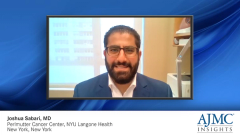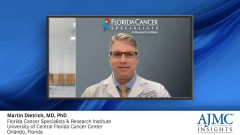
An Overview of NSCLC and Actionable Mutations
Joshua Sabari, MD, provides a breakdown of advanced non-small cell lung cancer (NSCLC) and its actionable mutations.
Episodes in this series

Joshua Sabari, MD: Non-small cell lung cancer is the third-most common diagnosis in the United States. About 235,000 cases are diagnosed a year in the United States. About 75% of these patients have advanced or Stage 4 disease. It's important to define the staging, imaging—MRI, PET, CT—and histology. When you look at the different histologies within non-small cell [lung cancer], [there is] most commonly adenocarcinoma and glandular cancer, [with squamous cell cancer as the second-most common]. In 2022, it’s critical to do molecular or biomarker testing on patients to understand if the patient has any driver alterations. We'll talk about multiple mutations that you can identify [that are] more commonly seen in patients who've never smoked, but you can also identify these alterations in patients who have smoked. We recommend doing next generation sequencing on all patients to identify EGFR and ALK mutations. If you identify a driver alteration, patients should be matched to targeted therapy that will target that actionable driver alteration. It improves patient survival, as well as their quality of life. If patients do not have a driver alteration who are smokers, we then look at the PD-L1 expression. That's a marker or a cloak disguised on the outside of cancer cells that will help predict how likely immunotherapy will work. If patients have a high PD-L1 expression of greater than 50%, I recommend in my practice to give immunotherapy alone, specifically pembrolizumab. That's based off the KEYNOTE-024 [trial]. If patients have a low PD-L1 expression that is less than 50 or zero, we recommend pembrolizumab plus chemotherapy based on the KEYNOTE-189 [trial]. It's critical to define the histology within non-small cell [lung cancer], whether it's adenocarcinoma or squamous, because the chemotherapeutics regimens differ. It's also critical to understand the biomarkers, particularly molecular testing tissue, as well as plasma NGS and PD-L1 expression, to help guide the optimal therapy for patients with Stage 4 non-small cell lung cancer.
About 60% of patients with advanced non-small cell lung cancer will be identified to have a driver alteration that is potentially actionable. The most common alteration that we see in non-small cell lung cancer is EGFR mutation. This occurs in about 20–25% of patients, and EGFR mutations occur in exon 19—that's a deletion—as well as L858R exon 21. This makes up about 80–85% of all EGFR mutations. There are also uncommon EGFR mutations that occur in 5–10% of patients, such as L861Q and others. Lastly, there are EGFR exon 20 insertion mutations, which occur also in about 5–10% of patients, depending on what literature you site. It's important to understand what specific EGFR mutation a patient has because you can match the patient to the best possible therapy. The second-most common alteration that we see is KRAS. If you look at KRAS overall, that's about 30% [of patients], but when we're talking about actionable alterations, KRAS G12C occurs in about 10–14% of patients. We recently had an FDA-approved agent in the second-line setting, sotorasib, which we'll talk about today, as well as in the KRAS G12C space. We then look at other alterations like ALK fusion. This occurs in about 3–4% of patients. We can look at RET alterations, or RET fusion, occurring in 1–2%, whilst 1 fusions in about 1% of patients. BRAF V600E mutations occur in 1–2% of patients. More recently, we identified MET exon 14 skip alterations, which occur in 3–5% of patients with non-small cell lung cancer. Lastly, the NTRK fusion, which occurs in about 0.5% [of patients]. It's important that we do broad panel next generation sequencing and not piecemeal testing because we have multiple driver alterations now with matched FDA approved therapies.
This transcript has been edited for clarity.
Newsletter
Stay ahead of policy, cost, and value—subscribe to AJMC for expert insights at the intersection of clinical care and health economics.
































































